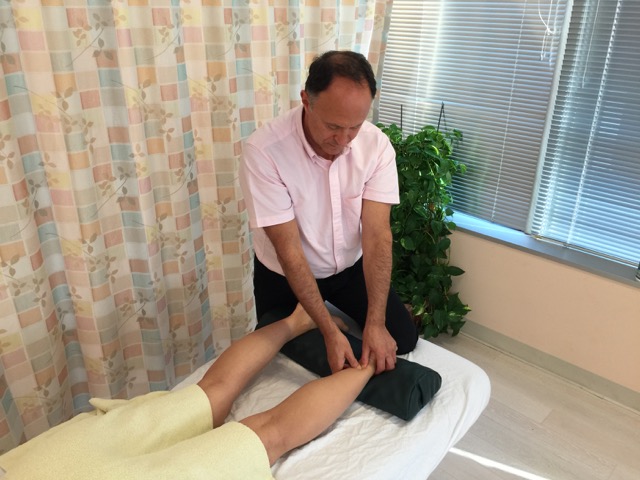Manual therapy treatment:

Cross-fiber soft tissue manipulation (massage) to the Achilles tendon. Permission: Joseph E. Muscolino.
During the acute inflammatory stage of Achilles tendinitis, manual therapy treatment is oriented toward decreasing inflammation and allowing the damaged tissue to heal. RICE (rest, ice, compression, and elevation) are recommended. Any soft tissue manipulation performed should be gentle and oriented from distal to proximal. Depending on the level of severity, gentle stretching can also be done. If the client/patient is limping, proactive work should be done to the rest of the lower extremities and the low back to help avoid dysfunction there as a result of the increased physical stress to these areas.
Stretching and strengthening the non-injured side triceps surae musculature can be beneficial because it has been shown to have some neural cross-over effect for the (other) injured side. Therefore, any work done to the non-injured side during the acute phase of the injury can help to some degree to prevent the development of excessive tightness and weakness of the injured musculature. This can help to speed up the rehabilitation process.
Once the acute stage has resolved and there is tissue integrity and inflammation has decreased, the goal of manual therapy is to decrease triceps surae hypertonicity and help break up/prevent the formation of excessive fascial adhesion scar tissue in the musculature and directly at the tendon. This can be accomplished by using moist heat, soft tissue manipulation, and stretching. Both longitudinal and cross-fiber strokes can be performed; usually cross-fiber strokes are more effective as the tendon is approached. Deep stroking massage and/or sustained compression can be used on the myofascial trigger points. Joint mobilization (arthrofascial stretching) of the joints and bones of the ankle/foot region should then be performed.
Associated disorders of the Achilles tendon
For acute Achilles bursitis, work directly over the bursae should be avoided.
If tendinosus is present, deeper work, especially cross fiber work at the tendon is indicated; the intent in this case is to create inflammation to bring in circulation and fibroblasts so that collagen scar tissue will be laid down to replace the degenerated tendinosus fibrous tissue.
If the client/patient experienced a complete rupture to the Achilles tendon, manual therapy does not have a direct role at the injured tendon and associated triceps surae group until after the tissue has healed post-surgery and the client’s/patient’s physician has given permission for bodywork to be performed. At that point in time, the goal is to loosen global tightness, myofascial trigger points, and adhesions present in the triceps surae muscles and the Achilles tendon itself. Certainly, manual therapy can and should have a role at the rest of the lower extremity, the contralateral lower extremity, and the low back to prevent possible compensatory overuse injury there.
Summary of Manual Therapy Treatment Protocol for Achilles Tendinitis/Paratendinitis/Bursitis
| 1. Acute stage: RICE with possible gentle distal-to-proximal effleurage and stretching |
| 2. Chronic stage: Moist heat, soft tissue manipulation (especially cross-fiber massage at the tendon region), and stretch |
| 3. Stretch and possible strengthen the contralateral (non-injured) triceps surae group. |
| 4. Joint mobilization (arthrofascial stretching) of the ankle/foot region |
| 5. If the client/patient is limping, proactively work the remainder of the lower extremity, the entire contralateral lower extremity, and the low back |
| 6. For Achilles tendinosus: Add in deeper cross-fiber work with the intent of creating inflammation to bring in fibroblasts to repair degenerated fascial tendon tissue. |
| 7. For Achilles tendon rupture: Once the physician has released the client/patient for care, soft tissue manipulation, stretching, and strengthening to the triceps surae musculature and the tendon, as well ankle/foot joint mobilization (arthrofascial stretching). |
Precautions/contraindications:
During the acute stage of Achilles tendon disorders, nothing should be done that would increase swelling and irritation to the structures involved; therefore, any soft tissue manipulation and stretching should be gentle in force.
If stretching or any deep work is done to the Achilles tendon, it is important to be sure that the client/patient is experiencing Achilles tendinitis and not an Achilles rupture.
The client/patient should also be advised that the use of steroidal or NSAID should be minimized or eliminated because of their possible destructive effect upon the myofascial tissue.


